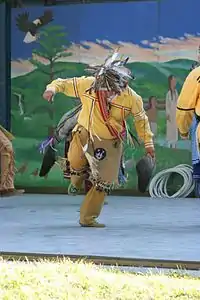Tree of Peace Society
The Tree of Peace Society was founded in 1984 and incorporated in New York State on October 17, 1994, as a "foreign" not-for-profit corporation ("foreign" a legal formality owing to tribal sovereignty considerations).[1] Its headquarters are located on the Akwesasne Mohawk reservation in Hogansburg, New York, which borders the provinces of Quebec and Ontario, Canada along the St. Lawrence River.

Since 1984, society members, headed by founder "Chief Jake Swamp" have ceremoniously planted trees in significant public places, such as near Philadelphia's Constitution Hall in 1986[2] and on April 10, 1986, at Shasta Hall, California State University, Sacramento, California[3] The organization's official website explains the ancient Native American legend behind the group's work:

The Great Tree of Peace [of the] Haudenosaunee (Iroquois) Confederacy -- Over a thousand years ago, the Peacemaker...Aiionwatha (Hiawatha) brought the Great Law of Peace (Kaianerekowa[6][7]) to the warring Indian nations of what is now New York State. The message of Peace, Power, and the Good Mind resulted in the forming of the Haudenosaunee Iroquois Confederacy. The league of nations consisted of the Mohawk, Oneida, Onondaga, Cayuga,and Seneca, and later the Tuscarora. These nations were instructed to bury their weapons of war under the Great Tree of Peace, and to unite as one to uphold the Great Law of Peace by joining "arms" so that the Tree of Peace would never fall."[8]
The educational website Past is Prologue[9] contains an article explaining more about how and why Trees of Peace are planted by the group:
"...Chief Jake Swamp of the Mohawk Nation and co-director of the Tree of Peace Society travels around the world planting Trees of Peace, including on the Smithsonian Mall during the Bicentennial celebration in honor of the contributions to the U.S. Constitution which came from the Iroquois Great Law of Peace. Such traditional ceremonies cannot, of course, be replicated by non-Iroquois...Suggestions for Ceremony: Call the group together with music. If a Native American drumming (much of which is sacred) group is available in your area, this would be appropriate. Form a circle around the tree. Readings could include The Great Tree of Peace from Three Strands in the Braid: A Guide for Enablers of Learning ...Select two items to be buried under the roots to symbolize national unity and peace. In the original ceremony, weapons of war were buried..."[10]
(Another book by the author of Three Strands in the Braid features cover art depicting Benjamin Franklin sitting under a Tree of Peace and negotiating with a chief in the Iroquois Grand Council.)[11]
References
- New York Department of State data: "Current Entity Name: TREE OF PEACE SOCIETY, INC. - Initial DOS Filing Date: OCTOBER 17, 1994 - County: FRANKLIN - Jurisdiction:DISTRICT OF COLUMBIA - Entity Type:FOREIGN NOT-FOR-PROFIT CORPORATION...
- The Great Law of Peace: New World Roots of American Democracy, by David Yarrow, September, 1987
- "TREE OF PEACE. Dedicated by Chief Jake Swamp of the Mohawk Nation, April 10, 1986. "When I look at this tree, May I be reminded that I laid down my weapons forever."
- "From beads to banner". Indian Country Today. Retrieved 2009-05-04.
- "Haudenosaunee Flag". First Americans. Retrieved 2007-09-25.
- Kaianerekowa Hotinonsionne – The Great Law of Peace of The Longhouse People
- "White Roots of Peace, Mohawk Nation; Kaianerekowa Hotinonsionne - The Great Law of Peace"
- 'The Great Tree of Peace' (explanation) © 2010 Tree of Peace Society
- "The Past Is Prologue Educational Program (PIP) is a program that teaches students the procedures involved in operating a democratic government. It facilitates critical thinking and governance. PIP uses three Native American Learning Stories from an Iroquois tradition to teach students..."
- PLANTING A TREE OF PEACE, author unknown, retrieved 07-24-2010
- Paula Underwood, 1997: Franklin listens when I speak: tellings of the friendship between Benjamin Franklin and Skenandoah, an Oneida Chief